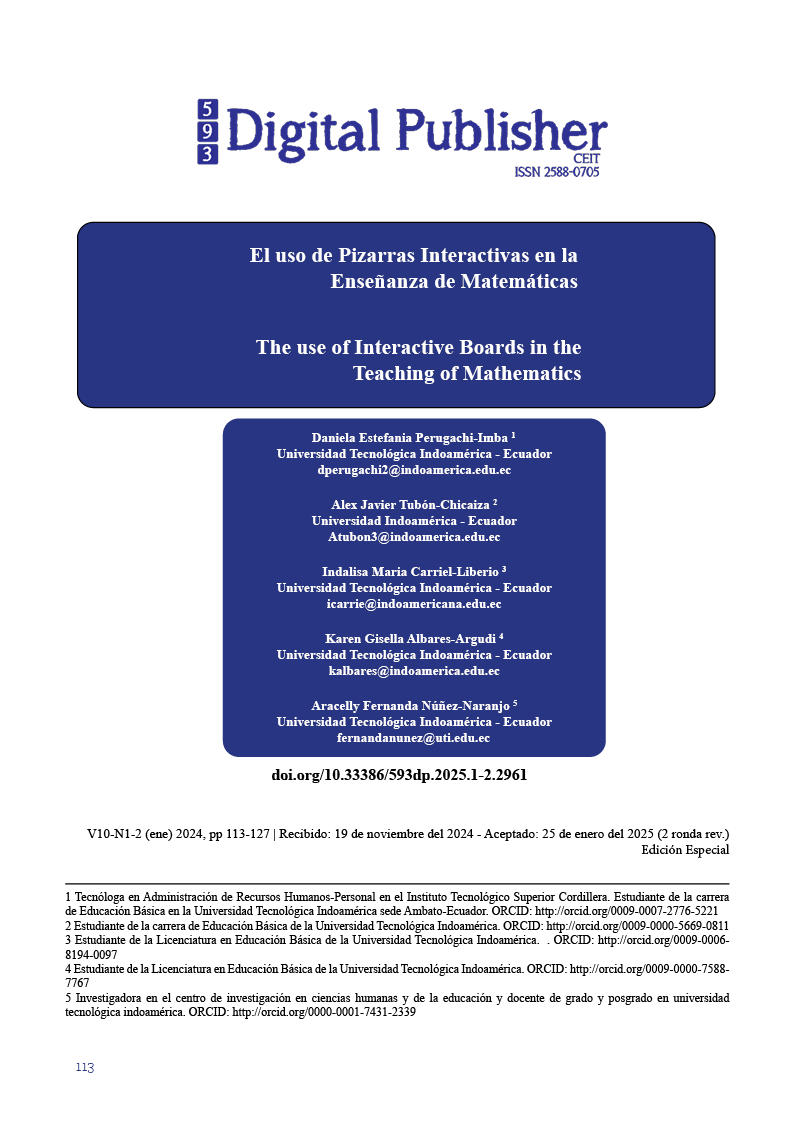The use of Interactive Boards in the Teaching of Mathematics
Main Article Content
Abstract
Introduction: The integration of technologies in education, such as interactive whiteboards, has attracted the attention of those interested in improving learning and teaching methodologies. In the field of mathematics teaching, these tools offer significant potential to transform classroom dynamics, although their impact on academic performance still generates controversy. Objective: Analyze how the use of interactive whiteboards in mathematics teaching influences the academic performance of students and the pedagogical practices of teachers. Methodology: A content análisis and a bibliographic review of articles published by various authors were carried out that covers various educational parameters from the importance of blackboards to the motivation that students have when using said tool. Results: It is considered that students and teachers do not find much. difference within their learning environment. Conclusion: No significant differences were found in academic performance between students who used interactive whiteboards and those who did not. However, its effectiveness is conditioned by challenges such as the lack of resources, the need for teacher training and the adequate integration of ICT. It is concluded that interactive whiteboards have great educational potential, but require careful implementation and continuous training.
Downloads
Article Details

This work is licensed under a Creative Commons Attribution-NonCommercial-ShareAlike 4.0 International License.
1. Derechos de autor
Las obras que se publican en 593 Digital Publisher CEIT están sujetas a los siguientes términos:
1.1. 593 Digital Publisher CEIT, conserva los derechos patrimoniales (copyright) de las obras publicadas, favorece y permite la reutilización de las mismas bajo la licencia Licencia Creative Commons 4.0 de Reconocimiento-NoComercial-CompartirIgual 4.0, por lo cual se pueden copiar, usar, difundir, transmitir y exponer públicamente, siempre que:
1.1.a. Se cite la autoría y fuente original de su publicación (revista, editorial, URL).
1.1.b. No se usen para fines comerciales u onerosos.
1.1.c. Se mencione la existencia y especificaciones de esta licencia de uso.
References
Ahsan, A., Najam, S., Ahmed, J., & Najam, Z. (2016). Interactive white board using gestures with KINECT. International Conference on Electrical, Electronics, and Optimization Techniques, ICEEOT 2016. https://doi.org/10.1109/ICEEOT.2016.7754805
Alfaro-Pérez, V., & Capetillo-Velásquez, R. (2024). Digital Teaching Competences in Pedagogy students of the University of Tarapacá. A case study in northern Chile. Aloma, 42(1), 69-78. https://doi.org/10.51698/aloma.2024.42.1.69-78
Annalakshmi, N., & Catherin Jayanthy, A. (2019). Investigation and analysis of technostress among teacher at higher secondary level. International Journal of Advanced Science and Technology, 28(19).
Ansyari, M. F., Groot, W., & De Witte, K. (2022). A systematic review and meta-analysis of data use professional development interventions. En Journal of Professional Capital and Community (Vol. 7, Número 3). https://doi.org/10.1108/JPCC-09-2021-0055
Arancibia-Gutiérrez, B., & Bustamante-Molina, M. (2019). Reader’s learning supported by the interactive digital Board: An empirical study. Magis, 12(24), 25-40. https://doi.org/10.11144/Javeriana.m12-24.alpd
Ardi Wijaya, & Maskuri Sutomo. (2023). Optimization of Tax Education Through Digital Content. IJESS International Journal of Education and Social Science, 4(1). https://doi.org/10.56371/ijess.v4i1.167
Aykat, Ş., & Günüç, S. (2020). Review of the opinions of vocational high school teachers, students, and administrators on the interactive whiteboard. En Turkish Online Journal of Qualitative Inquiry (Vol. 11, Número 1). https://doi.org/10.17569/tojqi.639139
Bagacina, E. B., Kilag, O. K. T., Andrin, Dr. G. R., Vidal, E. E., Ondog, J. D., & Lopez, S. M. (2024). Digital transformation in numeracy education : A study on teaching , learning , and leadership perspectives. International multi-disciplinary journal of education, 2(1).
Bourbour, M. (2023). Using digital technology in early education teaching: learning from teachers’ teaching practice with interactive whiteboard. En International Journal of Early Years Education (Vol. 31, Número 1). https://doi.org/10.1080/09669760.2020.1848523
Buchner, J., Buntins, K., & Kerres, M. (2022). The impact of augmented reality on cognitive load and performance: A systematic review. En Journal of Computer Assisted Learning (Vol. 38, Número 1). https://doi.org/10.1111/jcal.12617
César, J., Castellanos, C., Daniel, R., & Fonseca, T. (s. f.). IMPLEMENTACIÓN DE UNA PIZARRA DIGITAL INTERACTIVA MULTIUSUARIO CON DESARROLLO DE APLICACIÓN PARA TELE EDUCACIÓN EN PERSONAS CON CAPACIDADES DIFERENTES.
Choudhary, Y. (2023). Augmented Reality in Education. International Journal for Research in Applied Science and Engineering Technology, 11(11). https://doi.org/10.22214/ijraset.2023.56965
Colás Bravo, M. P., De Pablos Pons, J., & Pagán, J. B. (2018). The impact of ICT on teaching in the Spanish education system: A literature review. En Revista de Educación a Distancia (Número 56). Universidad de Murcia. https://doi.org/10.6018/red/56/2
Cumino, C., Pavignano, M., Spreafico, M. L., & Zich, U. (2019). Teaching geometry and surfaces evaluation through graphic representation and dynamic paper models. Advances in Intelligent Systems and Computing, 809. https://doi.org/10.1007/978-3-319-95588-9_135
Domingo Coscollola, M., & Marquès, P. (2013). Experimentación del uso didáctico de la pizarra digital interactiva (PDI) en el aula: plan formativo y resultados = Experimentation of the didactic use of an interactive whiteboard (iwb) in the classroom: Training plan and results = Expérimentation de l’utilisation didactique du tableau blanc interactif (tbi) en classe: Plan formatif et résultats. 31, 91-108.
Dudaitė, J., & Prakapas, R. (2019). Influence of use of Activinspire interactive whiteboards in classroom on students’ learning. Digital Education Review, 35. https://doi.org/10.1344/der.2019.35.299-308
Fleischmann, E., & van der Westhuizen, C. (2019). The Viability of a Bimodal Application of an Interactive-GIS-Tutor within Low-Resourced South African Schools. The Journal of Geography Education in Africa, 2(1). https://doi.org/10.46622/jogea.v2i1.2485
Fütterer, T., Scheiter, K., Cheng, X., & Stürmer, K. (2022). Quality beats frequency? Investigating students’ effort in learning when introducing technology in classrooms. Contemporary Educational Psychology, 69. https://doi.org/10.1016/j.cedpsych.2022.102042
Gallego, D. J.; C. M. L. D. J. (2009). 201017352009. 127-145.
García Paredes, N. E., Chiliquinga García, A. I., Román Cañizares, G. N., Zurita Guachamín, E. M., & Haro Sarango, A. F. (2023). Tecnologías de la información y las comunicaciones (TIC) en el aprendizaje universitario en el área de matemáticas. LATAM Revista Latinoamericana de Ciencias Sociales y Humanidades, 4(1). https://doi.org/10.56712/latam.v4i1.570
García-Martín, S., & Cantón-Mayo, I. (2019). Use of technologies and academic performance in adolescent students. Comunicar, 27(59), 73-81. https://doi.org/10.3916/C59-2019-07
González Carrasco, C., & Durán Medina, J. F. (2015). La pizarra digital interactiva como recurso potenciador de la motivación. Vivat Academia. Revista de Comunicación, 1-37. https://doi.org/10.15178/va.2015.132.1-37
Gros Salvat, B., & Silva Quiroz, J. (s. f.). LA FORMACIÓN DEL PROFESORADO COMO DOCENTE EN LOS ESPACIOS VIRTUALES DE APRENDIZAJE.
Guillén-Gámez, F. D., Ruiz-Palmero, J., Sánchez-Rivas, E., & Colomo-Magaña, E. (2020). ICT resources for research: an ANOVA analysis on the digital research skills of higher education teachers comparing the areas of knowledge within each gender. Education and Information Technologies, 25(5). https://doi.org/10.1007/s10639-020-10176-6
Herlina, E., & Abidin, Z. (2024). Development of interactive e-modules to improve students’ scientific literacy abilities: A literature review. Jurnal Mangifera Edu, 8(2). https://doi.org/10.31943/mangiferaedu.v8i2.181
Imoke, J. E., Ushe, B. C., & Ofem, B. E. (2024). Interactive/Smart Whiteboard and Student-Teachers Academic Performance in Educational Technology at the University of Calabar, Nigeria. European Journal of Contemporary Education and E-Learning, 2(1). https://doi.org/10.59324/ejceel.2024.2(1).14
Indah Sari, T., Surono, S., & Arroyo, E. (2022). Teachers’ Adaptation in The Use of Instructional Media In Teaching English as A Foreign Language at Junior High School In Sungai Penuh. Devotion : Journal of Research and Community Service, 3(12). https://doi.org/10.36418/dev.v3i12.249
Jacinto Escola, J. J. (2018). Aplicações das TIC no Ensino da Educação Física (Applications ICT in Teaching Physical Education). Retos, 34. https://doi.org/10.47197/retos.v0i34.65918
Junger, A. P., De Oliveira, V. I., Yamaguchi, C. K., De Oliveira, M. A. M. L., De Aguiar, H. M., & De Lima, B. L. S. (2023). The role of school management in technological practices as a tool for futuristic teaching. Revista de Gestão e Secretariado (Management and Administrative Professional Review), 14(7). https://doi.org/10.7769/gesec.v14i7.2426
Karakuş, U., & Varalan, E. İ. (2021). Developing the skills of students with mild intellectual disabilities using interactive map applications in a social studies course: An action research. Participatory Educational Research, 8(4). https://doi.org/10.17275/PER.21.86.8.4
Kearney, M., Schuck, S., Aubusson, P., & Burke, P. F. (2018). Teachers’ technology adoption and practices: lessons learned from the IWB phenomenon. Teacher Development, 22(4). https://doi.org/10.1080/13664530.2017.1363083
Kutluca, T., Yalman, M., & Tum, A. (2019). Use of Interactive Whiteboard in Teaching Mathematics for Sustainability and its Effect on the Role of Teacher. Discourse and Communication for Sustainable Education, 10(1). https://doi.org/10.2478/dcse-2019-0009
Lailiyah, S., Hayat, S., Urifah, S., & Setyawati, M. (2021). Levels of students’ mathematics anxieties and the impacts on online mathematics learning. Cakrawala Pendidikan, 40(1). https://doi.org/10.21831/cp.v40i1.36437
López, V., Grimalt-Álvaro, C., & Couso, D. (2018). ¿Cómo ayuda la Pizarra Digital Interactiva (PDI) a la hora de promover prácticas de indagación y modelización en el aula de ciencias? https://doi.org/10.25267/RevEurekaensendivulgcienc.2018.v15.i3.3302
Marshall, A. D. A., Hasdianda, M. A., Miyawaki, S., Jambaulikar, G. D., Cao, C., Chen, P., Baugh, C. W., Zhang, H., McCabe, J., Steinbach, L., King, S., Friedman, J., Su, J., Landman, A. B., & Chai, P. R. (2023). A Pilot of Digital Whiteboards for Improving Patient Satisfaction in the Emergency Department: Nonrandomized Controlled Trial. JMIR Formative Research, 7. https://doi.org/10.2196/44725
Mokoena, M. M., Simelane-Mnisi, S., & Mji, A. (2022). Challenges and Solutions for Teachers’ Use of Interactive Whiteboards in High Schools. Universal Journal of Educational Research, 10(1), 36-47. https://doi.org/10.13189/UJER.2022.100104
Morales, P. T., Manuel, J., & García, S. (2014). Current Status of Interactive Whiteboards in Primary Classrooms. En Revista de Educación a Distancia. Número (Vol. 43). http://www.um.es/ead/red/43
Nikulina, E. G., Kibishev, A. N., & Gribkov, D. N. (2023). Peculiarities of using virtual whiteboards to form the professional competence of future lawyers in foreign language classes at university. RUDN Journal of Informatization in Education, 20(1). https://doi.org/10.22363/2312-8631-2023-20-1-93-103
Núñez-Hernández, C., & Nunez-Naranjo, A. (2023). Academic Tutoring in Virtual Education: A Case Study in University Students. ECTM 2023 - 2023 IEEE 7th Ecuador Technical Chapters Meeting. https://doi.org/10.1109/ETCM58927.2023.10308803
Núñez-Naranjo, A., Cumbicus, F. C., & Ocaña, J. M. (2024). TIC as a Didactic Tool for the Development of Reading Comprehension. Lecture Notes in Networks and Systems, 773, 144-154. https://doi.org/10.1007/978-3-031-44131-8_15
Nyambane, C. O., & Nzuki, D. M. (2019). Influence of ICT Capacity on Effective Utilization of ICT to Improve Organizational Performance of Learning Institutions: A Literature Review. European Scientific Journal ESJ, 15(31). https://doi.org/10.19044/esj.2019.v15n31p264
Nzaramyimana, E., & Umugiraneza, O. (2024). Investigating teachers’ technological pedagogical content knowledge in teaching mathematics in Rwanda secondary schools. Education and Information Technologies, 29(11). https://doi.org/10.1007/s10639-023-12403-2
Orellana-Campoverde, J. A., & Erazo-Álvarez, J. C. (2021). Herramientas digitales para la enseñanza de Matemáticas en pandemia: Usos y aplicaciones de Docentes. EPISTEME KOINONIA, 4(8). https://doi.org/10.35381/e.k.v4i8.1348
Quiroz Calderón, G. A., Aguilera, K., & Elizalde, E. (2020). Preferencias en Modalidades de Clases y sus Herramientas. Revista Tecnológica - ESPOL, 32(2). https://doi.org/10.37815/rte.v32n2.771
Rodríguez, M. L. (2019). Challenges and constraints of the education in Latin America. A comparative analysis. Foro de Educacion, 17(27), 229-251. https://doi.org/10.14516/fde.645
Sánchez Vera, M. M. (2023). Los desafíos de la Tecnología Educativa. Revista Interuniversitaria de Investigación en Tecnología Educativa, 1-5. https://doi.org/10.6018/riite.572131
Sánchez-Rojo, A., Alonso-Sainz, T., & Martín-Lucas, J. (2024). PEDAGOGY IN THE FACE OF THE DIGITAL CHALLENGE: NEW MATERIALITIES. Teoria de la Educacion, 36(2), 25-42. https://doi.org/10.14201/teri.31752
Stockless, A., Villeneuve, S., & Gingras, B. (2018a). Maitrise d’outils technologiques : son influence sur la compétence TIC des enseignants et les usages pédagogiques. La revue canadienne de l’apprentissage et de la technologie, 44(2).
Stockless, A., Villeneuve, S., & Gingras, B. (2018b). Maitrise d’outils technologiques: son influence sur la compétence TIC des enseignants et les usages pédagogiques | Mastery of Digital Tools: The Influence on Information and Communication Technologies Competency and Pedagogical Use. Canadian Journal of Learning and Technology, 44(2). https://doi.org/10.21432/cjlt27581
T.A. Goodison. (2002). Learning with ICT at primary level: pupils’ perceptions.
Tashtoush, M. A., AlAli, R., Wardat, Y., Alshraifin, N., & Toubat, H. (2023). The Impact of Information and Communication Technologies (ICT)-Based Education on the Mathematics Academic Enthusiasm. Journal of Educational and Social Research, 13(3). https://doi.org/10.36941/jesr-2023-0077
The Use of Interactive Whiteboard in Teaching Mathematics and Statistics. (2022). International Journal of Advanced Research in Education and Society. https://doi.org/10.55057/ijares.2022.4.3.8
Universities, C. (2017). Technology’s past, present and future role in education. Autumn.
Valiente-Barroso, B., Valiente-Barroso, C., Garcia García, E., & Lena Acebo, F. J. (2011). NEW TECHNOLOGY IN SECONDARY EDUCATION: KEY CONSIDERATIONS IN TEACHER INDUCTION. 2011 4TH INTERNATIONAL CONFERENCE OF EDUCATION, RESEARCH AND INNOVATION (ICERI).
Vázquez Cancelo, M. J., & Santos Caamaño, F. J. (2017). La motivación en el aprendizaje de las matemáticas con Pizarra Digital Interactiva. Revista de Estudios e Investigación en Psicología y Educación, 073-076. https://doi.org/10.17979/reipe.2017.0.13.2329
Vu, N. N., Phuong, L. T. T., Lien, N. T. H., & Luong, N. T. (2020). Using interactive whiteboard for teaching vocabulary to young English learners: Students’ performance and perceptions. Journal of Critical Reviews, 7(19).
Zhou, C., & Lewis, M. (2021). A mobile technology-based cooperative learning platform for undergraduate biology courses in common college classrooms. Biochemistry and Molecular Biology Education, 49(3). https://doi.org/10.1002/bmb.21496






